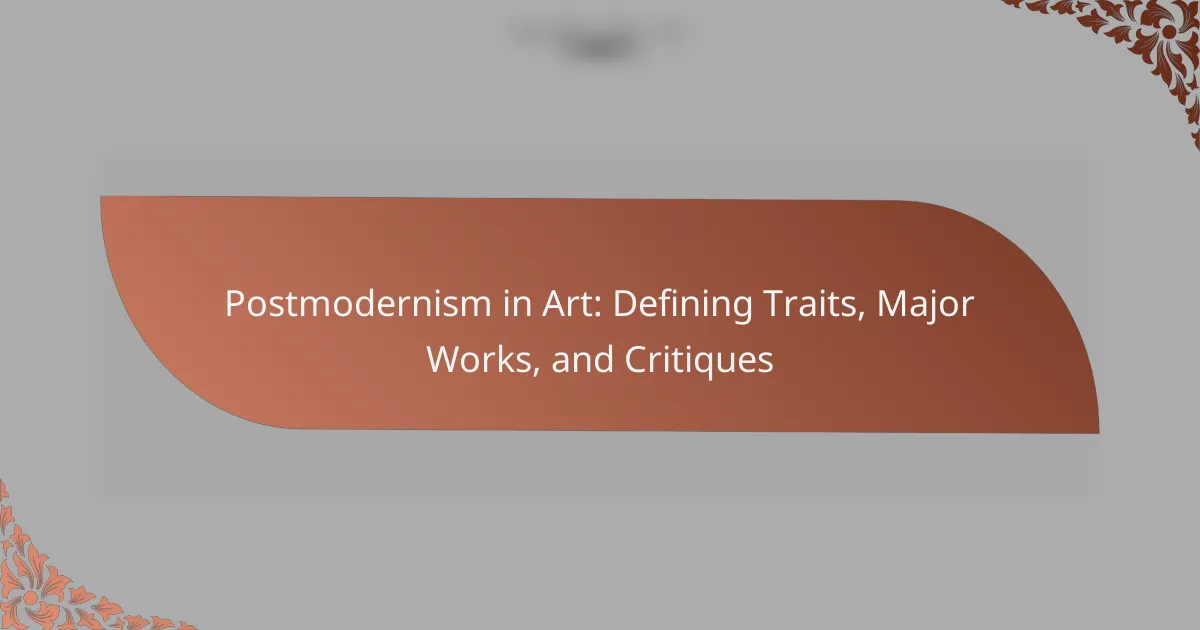Postmodernism in art challenges traditional boundaries and invites diverse interpretations. Key traits include irony, eclecticism, and pastiche. Major works by artists like Marcel Duchamp and Cindy Sherman exemplify these characteristics. Critiques often focus on perceived superficiality and the risk of cultural homogenization.

What are the defining characteristics of postmodernism in art?
Postmodernism in art is characterized by its embrace of diversity, irony, and rejection of grand narratives. Key traits include eclecticism, pastiche, and a focus on the viewer’s interpretation. Major works often challenge traditional boundaries, as seen in the installations of artists like Damien Hirst and Jeff Koons. Critiques highlight its tendency towards superficiality and the commodification of art.
How does postmodernism challenge traditional artistic values?
Postmodernism challenges traditional artistic values by emphasizing pluralism, irony, and self-referentiality. It rejects the notion of a single narrative or truth, promoting diverse perspectives. This shift leads to the deconstruction of established norms, encouraging artists to explore unconventional forms and techniques. Major works, such as those by Andy Warhol and Cindy Sherman, exemplify these traits through their playful critique of consumer culture and identity. As a result, postmodernism reshapes the understanding of art’s purpose, moving away from beauty and technical skill toward conceptual depth and social commentary.
What role does irony play in postmodern art?
Irony serves as a critical tool in postmodern art, highlighting contradictions and questioning established norms. It often blurs the line between reality and representation, creating a sense of ambiguity. Artists use irony to challenge viewers’ perceptions, encouraging deeper engagement with the artwork. Major works, like those by Andy Warhol, exemplify how irony can critique consumer culture. This approach fosters a dialogue about authenticity and meaning in art, reflecting the complexities of contemporary society.
Which mediums are commonly associated with postmodern art?
Postmodern art commonly utilizes diverse mediums, including installation, performance, video, and digital art. These forms challenge traditional boundaries and engage viewers in interactive experiences. Notable examples include multimedia installations by artists like Yayoi Kusama and video art by Bill Viola. The use of mixed media allows for a blend of various artistic expressions, emphasizing the fluidity of postmodernism.
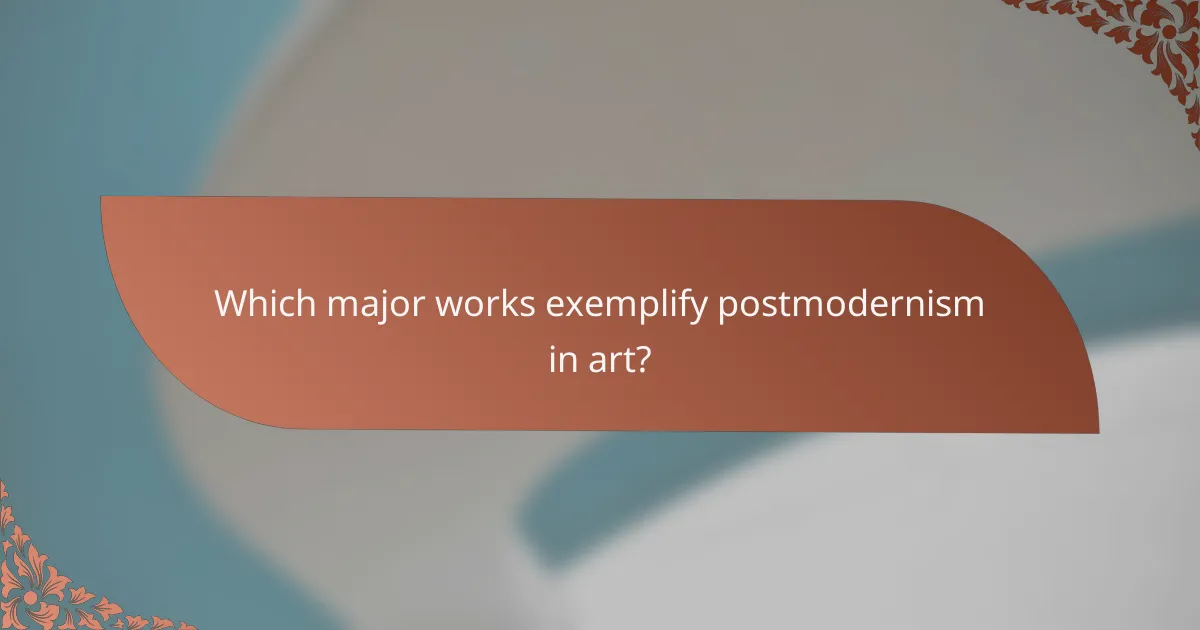
Which major works exemplify postmodernism in art?
Key works exemplifying postmodernism in art include “Fountain” by Marcel Duchamp, “The Dinner Party” by Judy Chicago, and “Untitled Film Stills” by Cindy Sherman. These pieces reflect the movement’s traits such as irony, pastiche, and the questioning of traditional narratives. Duchamp’s work challenges the definition of art, while Chicago’s installation addresses feminist themes. Sherman’s series critiques the construction of female identity in media.
Who are the key artists associated with postmodernism?
Key artists associated with postmodernism include Andy Warhol, Cindy Sherman, Jean-Michel Basquiat, and Damien Hirst. These artists challenged traditional concepts of art through unique styles and provocative themes. Warhol’s use of consumer culture and mass production, Sherman’s exploration of identity and representation, Basquiat’s raw street art, and Hirst’s controversial installations exemplify postmodern traits. Their works often blur boundaries between high and low art, reflecting a diverse range of influences and critiques.
What are some landmark exhibitions featuring postmodern art?
Landmark exhibitions featuring postmodern art include the “Sensation” exhibition at the Royal Academy of Arts in 1997, which showcased Young British Artists. Another significant event is the “The Last Judgment” exhibition at the Museum of Modern Art in 1990, highlighting themes of mortality and identity. Additionally, “The Anti-Design” exhibition at the Museum of Contemporary Art in 1979 challenged traditional design principles, reflecting postmodernism’s critical stance. Lastly, “Postmodernism: Style and Subversion 1970-1990” at the Victoria and Albert Museum in 2011 explored the diverse manifestations of postmodern art and design.
How do these works reflect cultural and social contexts?
Postmodernism in art reflects cultural and social contexts through its emphasis on fragmentation, irony, and diversity. Artists challenge traditional narratives and embrace multiple perspectives. For example, works by Andy Warhol critique consumer culture while addressing identity and media saturation. The movement often incorporates elements from various styles and eras, highlighting the interconnectedness of global influences. This approach mirrors the complexity of contemporary society, where boundaries between high and low culture blur.
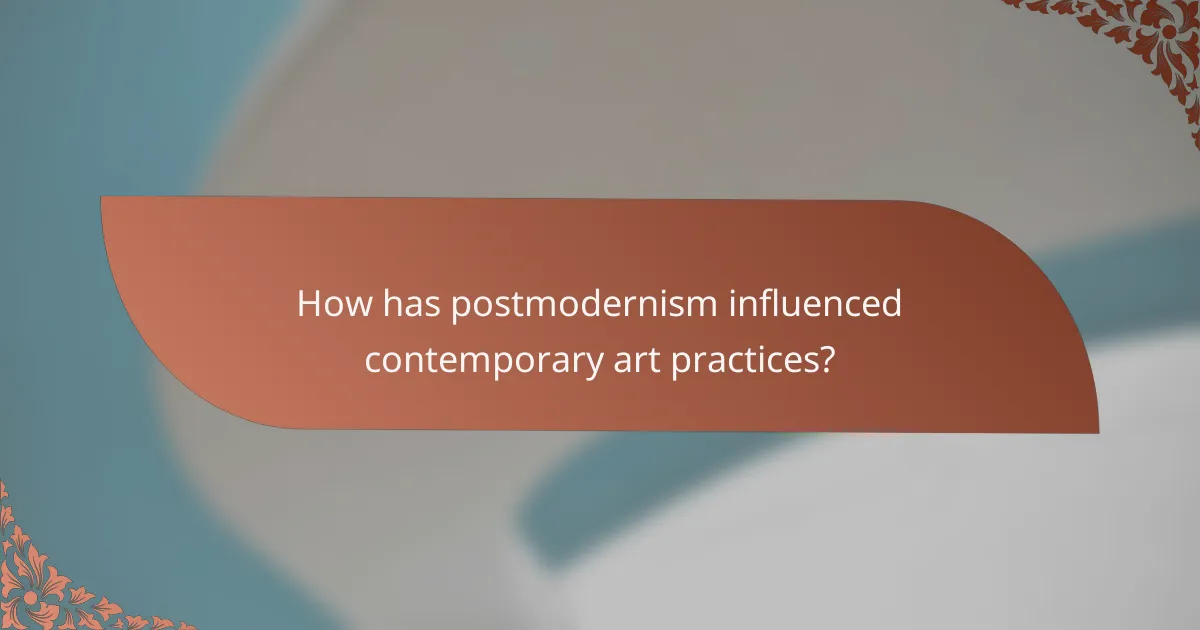
How has postmodernism influenced contemporary art practices?
Postmodernism has profoundly influenced contemporary art practices by challenging traditional narratives and embracing diverse mediums. This movement encourages artists to explore identity, culture, and technology, often blurring the lines between high and low art.
Key traits include appropriation, pastiche, and irony. Major works, such as those by Andy Warhol and Cindy Sherman, exemplify these characteristics. Critiques of postmodernism often focus on its perceived nihilism and the risk of cultural homogenization.
As a result, contemporary artists frequently adopt a pluralistic approach, integrating various styles and perspectives into their work. This has led to a rich tapestry of artistic expression that reflects the complexities of modern society.
What new movements have emerged from postmodernism?
New movements emerging from postmodernism include conceptual art, installation art, and digital art. These movements challenge traditional boundaries and emphasize ideas over aesthetics. For example, conceptual art prioritizes the concept behind the work, while installation art transforms spaces into immersive experiences. Digital art leverages technology, introducing new forms of creativity and interaction. Each of these movements reflects the postmodern tendency to question established norms and embrace diversity in artistic expression.
How do artists today reinterpret postmodern concepts?
Artists today reinterpret postmodern concepts by blending traditional techniques with contemporary themes. They explore identity, culture, and technology, often challenging established norms. For example, some artists use digital media to create interactive installations that question the nature of reality. This unique approach reflects postmodernism’s fluidity, embracing ambiguity and multiplicity. Additionally, they often critique consumerism and globalization, echoing postmodernism’s skepticism towards grand narratives.
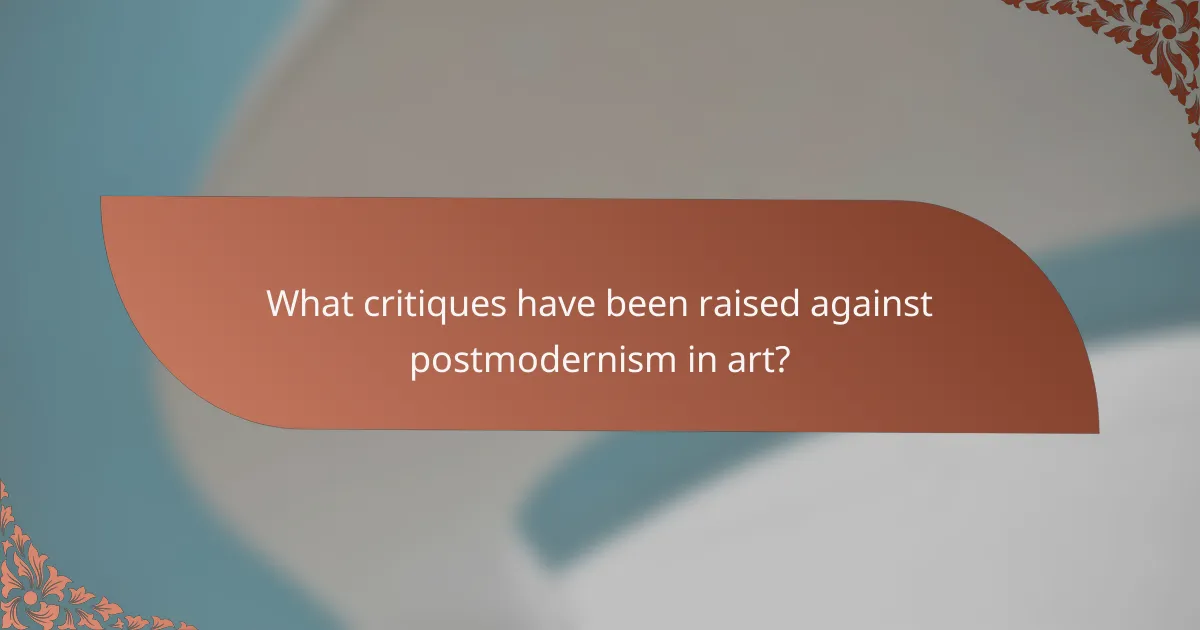
What critiques have been raised against postmodernism in art?
Critiques of postmodernism in art often focus on its perceived lack of originality, depth, and coherence. Critics argue that postmodern works frequently rely on pastiche and irony, undermining genuine artistic expression. Additionally, some contend that postmodernism’s emphasis on relativism dilutes the value of objective standards in art. This has led to debates about authenticity and meaning in contemporary artistic practices.
Which philosophical arguments challenge postmodernist views?
Philosophical arguments challenging postmodernist views include critiques of relativism, skepticism about truth, and the rejection of grand narratives. These arguments emphasize objective reality, universal truths, and the importance of historical context. Key philosophers such as Jürgen Habermas and Richard Rorty argue that postmodernism undermines rational discourse and ethical foundations. Additionally, critics highlight the potential for nihilism within postmodern thought, questioning its implications for meaning and value in art and society.
How do critics perceive the role of meaning in postmodern art?
Critics often view the role of meaning in postmodern art as fragmented and subjective. This perspective emphasizes the absence of a singular narrative, reflecting diverse interpretations. Postmodern art challenges traditional values, encouraging viewers to derive personal significance from artworks. Critics argue this leads to a democratization of meaning, where each observer’s experience holds equal weight. Prominent works, such as those by Andy Warhol and Cindy Sherman, exemplify this shift, showcasing how context and perception shape artistic value.
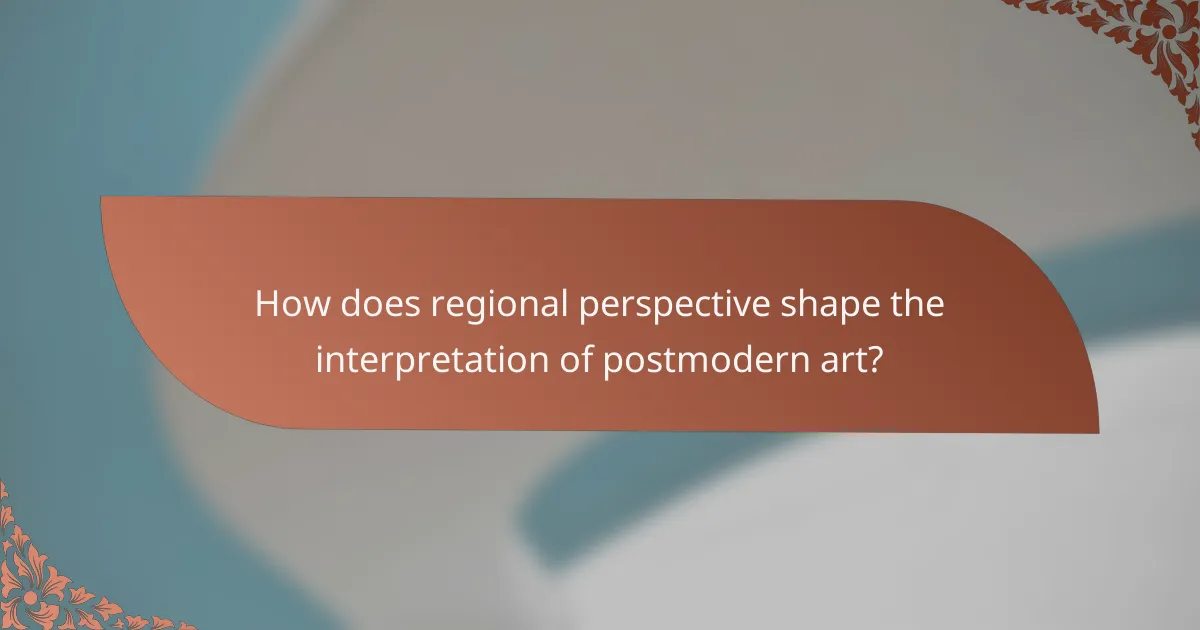
How does regional perspective shape the interpretation of postmodern art?
Regional perspective significantly influences the interpretation of postmodern art. Different cultural backgrounds shape how individuals perceive and critique artistic expressions. For instance, Western viewpoints may emphasize individualism, while Eastern perspectives might focus on community and tradition. This diversity in interpretation leads to varied understandings of major postmodern works, such as those by artists like Jeff Koons and Yayoi Kusama. Additionally, regional historical contexts can alter the significance of art movements, affecting their reception and critique. Understanding these perspectives enriches the discourse surrounding postmodernism in art.
What are the differences in postmodern art reception across cultures?
Postmodern art reception varies significantly across cultures due to differing historical contexts, societal values, and aesthetic preferences. For instance, Western cultures often emphasize individualism and conceptual frameworks, while Eastern cultures may prioritize collective narratives and harmony. Additionally, the interpretation of postmodern works can differ based on local art traditions and the influence of globalization. Cultural institutions and education also shape how postmodern art is understood and valued, leading to diverse receptions worldwide.
How do local art scenes influence postmodern expressions?
Local art scenes significantly shape postmodern expressions by fostering diverse perspectives and innovative styles. These scenes create platforms for artists to challenge traditional norms and experiment with mixed media. Local influences often lead to unique interpretations of cultural themes, reflecting the community’s identity. For instance, urban environments inspire street art that critiques societal issues. Additionally, collaborative projects within these scenes promote cross-disciplinary approaches, enhancing postmodern dialogue. Ultimately, local art scenes contribute to the evolution of postmodernism by nurturing creativity and encouraging critical discourse.
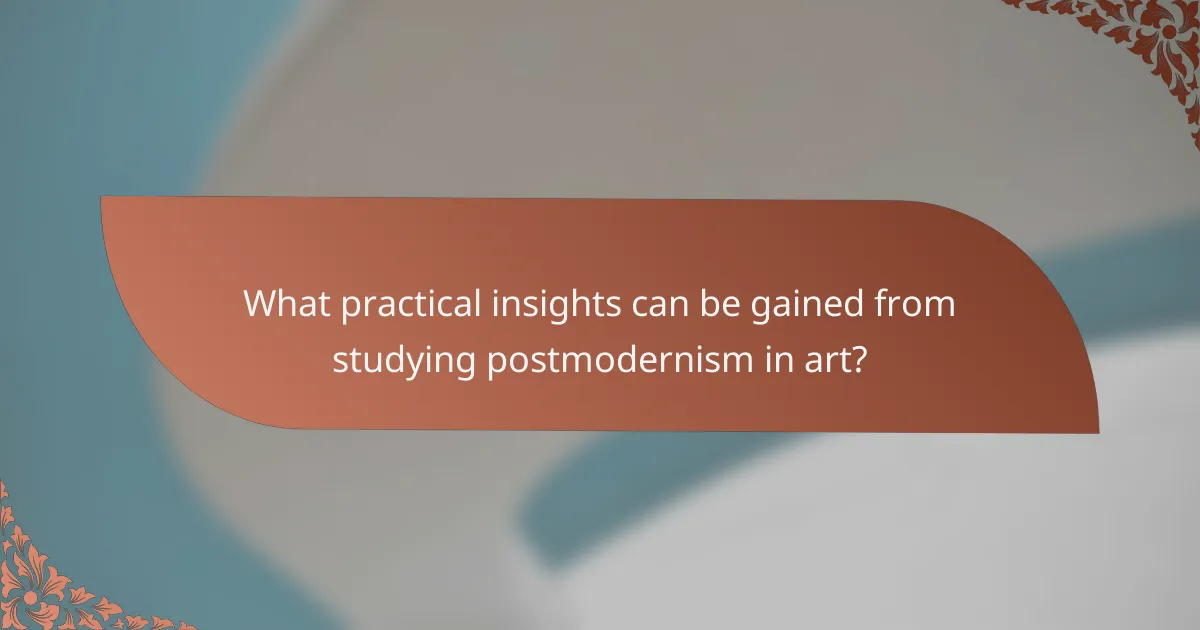
What practical insights can be gained from studying postmodernism in art?
Studying postmodernism in art reveals insights into cultural diversity, the questioning of traditional narratives, and the blending of high and low art. This movement encourages critical thinking about representation and meaning in contemporary society. By analyzing major works, one can appreciate the unique attributes of artists like Andy Warhol and Cindy Sherman, who challenge established norms. Engaging with postmodern critiques fosters a deeper understanding of the complexities within art and its societal implications.
What are best practices for engaging with postmodern art?
Engaging with postmodern art involves embracing its complexity and diversity. Focus on the following best practices:
1. Approach with an open mind to appreciate various interpretations.
2. Research the historical and cultural contexts behind the artwork.
3. Attend exhibitions and discussions to gain deeper insights.
4. Participate in interactive experiences that invite personal reflection.
5. Analyze the use of irony and pastiche, common in postmodern works.
How can one avoid common misconceptions about postmodernism?
To avoid common misconceptions about postmodernism, one should focus on its defining traits, major works, and critiques. Recognizing postmodernism’s emphasis on pluralism and irony helps dispel myths of uniformity. Engaging with key artists and their works, like Andy Warhol and his commentary on consumerism, clarifies its diverse expressions. Understanding critiques, such as those from modernism proponents, reveals the ongoing debates surrounding its relevance and impact in contemporary art.
